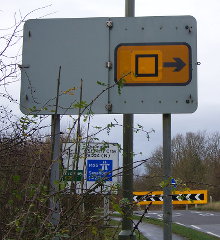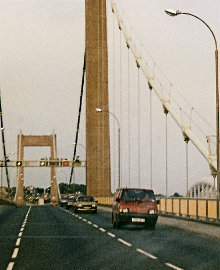There have been changeable message signs for longer than you might think. While automated, remote control and electronic signs might have been developments from the 1960s and 70s, other more basic types of changeable sign had been around for much longer.
The creation of parking controls to reduce city centre congestion created a need for a particularly odd changeable sign, which was deployed on streets where parking would only be allowed on one side. Frequently, traders on opposite sides of the street wanted parking to be allowed on their half of the street, claiming that banning parking in front of their shops would harm trade.


The solution was to alternate the side where parking was permitted day by day, and to achieve this, signs were put up along both kerbs with a hinged flap that could be used to display or hide the parking restriction.
Each night, policemen (who presumably had less to do in those days) would walk down both sides of the street, turning the signs over to swap the parking restriction. Some of the signs lasted until the 1970s but it's thought that they are now all gone.
Manually operated signs are still installed today, of course — one of the most familiar uses for them is at the beginning of motorway diversion routes, where a "trigger" sign (like the one on the right) indicating the diversion symbol is hidden by a hinged flap and is manually uncovered by the police or traffic officers when the diversion route is needed.
(There's a full explanation of this whole system on the Emergency Diversion Routes page.)
Secret signs
The start of the motorway age coincided with the development of technologies that would allow changeable signs to operate automatically.

Rural motorways, like the earliest sections of M1 and M6, didn't seem to have any need for changeable signs at first, but the design for the London end of the M4 called for a lengthy, narrow viaduct snaking through the rooftops of Brentford, and even at the design stage it was recognised that an accident there would cause serious problems. What motorists needed were warnings of problems on the viaduct so they could avoid it entirely.
In July 1961 — four years before it opened, and some time before work had even started on building it — the Ministry of Transport was consulting with the police on what they could do to make sure this unusual viaduct was safe.
The initial solution was to install emergency telephones every quarter of a mile on the viaduct section, rather than just every mile, but this alone was not going to be enough. Based on experience with the Mersey Tunnel, a similarly constricted four-lane road, the Ministry estimated that the elevated section of the M4 would suffer about 12 breakdowns every day. Even in the best case, every one of those would halve the capacity of one side of the motorway until the stricken vehicle could be recovered.
A working party was set up with representatives from the Metropolitan Police and the Road Research Laboratory to suggest new ways to help keep the traffic moving. They proposed two things: a surveillance system for the police, and better signs for drivers.
The surveillance system involved 30 detector loops embedded in the carriageways and sliproads of the M4 to feed data into a "panoramic display" at the police control room, along with three remote control "television cameras" mounted on nearby buildings so that the control room operator would be able to see live pictures of the whole elevated motorway. Remotely operated CCTV cameras are commonplace now but were a real novelty when installed for the M4, and the specially-designed equipment to enable them to move at the command of the control room took a long time to become reliable.
The information system was also something new and untested:
"Breakdowns during peak hours in particular could cause serious congestion unless quick action is taken to divert traffic and prevent piling up behind break-downs or accidents. To achieve this we propose to install emergency signs at the appropriate junctions to prevent vehicles gaining access to the motorway and committing themselves to the viaduct section."
These "secret signs" were linked — by cables and wireless transmitters — to the police control room in Hounslow, with the intention that the operator could switch them on when their magnificent panoramic display and camera feeds started to indicate problems.
The cost of the whole system was estimated at £34,500, including £6,750 for the manufacture of the special changeable signs.
Unfortunately the design of the signs, and the wording of their message, seems to have been lost. But it's safe to assume they weren't very sophisticated, because it wasn't until 1964 that sign manufacturers started to come up with realistic ways to produce something that could show a message when lit up and that would appear completely blank at other times.
Conquering sunlight

As investment in the road network increased during the late 1950s and early 1960s, the design of roads and methods of managing the traffic upon them rapidly became more sophisticated. New ideas were plentiful and the key problem for the emerging discipline of traffic engineering was that the things engineers wanted to accomplish were still some way ahead of the technology. The practical solutions just didn't exist to make signs that could show one thing or another depending on the time of day, or the weather, or even the volume of traffic.
In fact, development work was needed at a fairly basic level. Between 1962 and 1964, a company called Bergo (who continued making all kinds of street furniture into the 1980s) began developing technology for illuminated signs. In February 1962 they supplied lane indication signs for the Tamar Bridge, which were supposed to be switched on and off to open and close lanes to traffic, but they found that during daylight hours the sign face was clearly visible even when not illuminated, and the lamps inside weren't bright enough to be noticeable when the sun was shining on them. They were replaced with entirely different signs very soon afterwards, and the light-up signs were consigned to the bin.
Similar signs were supplied for the Clyde Tunnel in 1963, where lane indicators were successfully designed that were visible when illuminated but completely blank when switched off. However, they only really worked because the tunnel had artificial lighting and sun glare wasn't a problem.
By 1964, Bergo thought they may have a solution, and a delegation from the Ministry of Transport were invited to visit their workshops in Watford.
In the yard at the foot of the Metropolitan Line embankment, Bergo's engineers demonstrated their breakthrough: a lens 40 centimetres (16 inches) across that was completely black, even in direct sunlight, but which could then be illuminated. They put several masks over the light to show a red cross, as in a lane indicator; the word ICE; and the outline of a letter E, to demonstrate the concept.
With — at last — some working technology, there was now the possibility to begin trying out new ideas to keep the traffic flowing.
Picture credits
- Changeable "no waiting" and "waiting limited" sign taken from fingerpostsigns.com
-
Photograph of Tamar Bridge adapted from an original by Stuart Logan and used under this Creative Commons licence.

